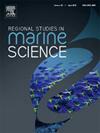Temporal variability of microplastics contaminant ingested by striped barnacles Amphibalanus amphitrite in tidal flat of the Tsurumi River estuary, Tokyo Bay Area, Japan
IF 2.1
4区 环境科学与生态学
Q3 ECOLOGY
引用次数: 0
Abstract
Microplastic pollution is an emergent and serious environmental threat to the aquatic environment, hence, understanding their fate, transportation and concentrations is vital for addressing such threat. The knowledge of bio-contamination of microplastics in continuous time scale within specific location area is limited. Therefore, in this study, we investigated the temporal variability of microplastics contaminant ingested by striped barnacle Amphibalanus amphitrite over a one-year period in the Tsurumi River Tidal Flat within the Tokyo Bay area, Japan. The overall mean MPs concentration in striped barnacles was 14.07 ± 1.44 MPs /wet weight (g−1) or 3.88 ± 0.42 MPs/ individual. The highest concentration was observed in November (26.60 ± 7.07 MPs number/body weight (g−1) or 8.90 ± 2.34 MPs/ individual), whereas, the lowest concentration was observed in July (4.53 ± 1.78 MPs number/body weight (g−1) or 1.50 ± 0.60 MPs/ individual). Statistical analysis detected significant differences in the overall MPs concentration (p = 0.005). The dominant type of MPs was fragment (66 %), followed by fiber (17 %), pellet (12 %) and film (5 %). A total of 23 polymer types were identified with µFT-IR. Polyethylene was the most abundant polymer type with 33 % of the total particles identified, followed Polyamide with 13 %, Melamine Urea-Formaldehyde with 12 %, Phenol Formaldehyde with 10 % and Polyether 7 % respectively. The results obtained in this study confirms the exposure of microplastics contaminant to stripped barnacles in their natural environment and highlights that concentration values fluctuate over time even within a specific area.
求助全文
约1分钟内获得全文
求助全文
来源期刊

Regional Studies in Marine Science
Agricultural and Biological Sciences-Ecology, Evolution, Behavior and Systematics
CiteScore
3.90
自引率
4.80%
发文量
336
审稿时长
69 days
期刊介绍:
REGIONAL STUDIES IN MARINE SCIENCE will publish scientifically sound papers on regional aspects of maritime and marine resources in estuaries, coastal zones, continental shelf, the seas and oceans.
 求助内容:
求助内容: 应助结果提醒方式:
应助结果提醒方式:


